What are voltage, current and resistance: how they are used in practice
In electrical engineering, the terms "current", "voltage" and "resistance" are used to describe the processes occurring in electrical circuits. Each of them has its own purpose with specific characteristics.
Electricity
The word is used to characterize the movement of charged particles (electrons, holes, cations and anions) through a certain medium of a substance. The direction and number of charge carriers determines the type and strength of the current.
The main characteristics of current affect its practical application
A prerequisite for the flow of charges is the presence of a circuit or, in other words, a closed loop that creates conditions for their movement. If a void forms inside the moving particles, their directional movement immediately stops.
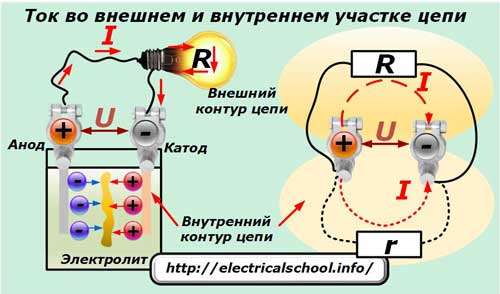
All switches and protections used in electricity work on this principle.They create a separation between the moving contacts of the conductive parts and through this action interrupt the flow of electric current, shutting down the device.
In energy, the most common method is the creation of an electric current due to the movement of electrons inside metals made in the form of wires, tires or other conductive parts.
In addition to this method, the creation of current inside is also used:
1. gases and electrolytic liquids due to the movement of electrons or cations and anions — ions with positive and negative charge signs;
2. an environment of vacuum, air and gases subjected to the movement of electrons caused by the phenomenon of thermionic radiation;
3. semiconductor materials due to the movement of electrons and holes.
An electric shock can occur when:
-
applying an external electric potential difference to charged particles;
-
heating wires that are not currently superconductors;
-
the course of chemical reactions related to the release of new substances;
-
the effect of a magnetic field applied to the wire.
The waveform of the electric current can be:
1. a constant in the form of a straight line on the timeline;
2. a variable sinusoidal harmonic well described by the basic trigonometric relations;
3. meander, roughly resembling a sine wave, but with sharp, pronounced angles, which in some cases can be well smoothed;
4. pulsating, when the direction remains the same without change, and the amplitude periodically fluctuates from zero to the maximum value according to a well-defined law.
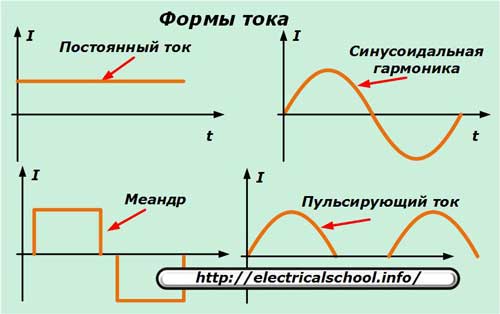
Electric current can be useful to a person when:
-
converted into light radiation;
-
creates heating of thermal elements;
-
performs mechanical work due to the attraction or repulsion of movable armatures or the rotation of rotors with drives fixed in bearings;
-
generates electromagnetic radiation in some other cases.
When electric current passes through wires, damage can be caused by:
-
excessive heating of current-carrying circuits and contacts;
-
education eddy currents in the magnetic circuits of electrical machines;
-
radiation of electricity electromagnetic waves in the environment and some similar phenomena.
Designers of electrical devices and developers of various circuits take into account the listed possibilities of electric current in their devices. For example, the harmful effects of eddy currents in transformers, motors and generators are mitigated by mixing the cores used to transmit magnetic fluxes. At the same time, the eddy current is successfully used to heat the medium in electric ovens and microwave ovens operating on the induction principle.
An alternating electric current with a sinusoidal waveform can have a different frequency of oscillation per unit time — a second. The industrial frequency of electrical installations in different countries is standardized with the numbers 50 or 60 hertz. For other purposes of electrical engineering and radio business, signals are used:
-
low-frequency, with lower values;
-
high frequency, significantly exceeding the range of industrial devices.
It is generally accepted that an electric current is created by the movement of charged particles in a certain macroscopic medium and is called a conduction current... However, another type of current called convection can occur when macroscopically charged bodies move, for example, raindrops .
How electric current is formed in metals
The movement of electrons under the influence of a constant force applied to them can be compared to the descent of a parachutist with an open canopy. In both cases, a uniformly accelerated motion is obtained.
The skydiver moves due to gravity towards the ground, which is opposed by the force of air resistance. Electrons are affected by the force applied to them electric field, and its movement is impeded by continuous collisions with other particles — ions of crystal lattices, due to which part of the effect of the applied force is extinguished.
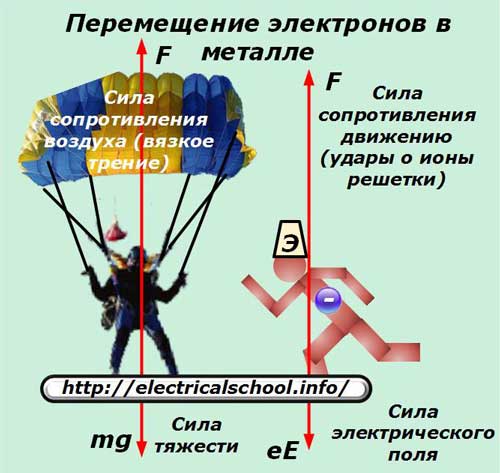
In both cases, the average speed of the parachutist and the electron movement reaches a constant value.
This creates a rather unique situation where the speed:
-
the proper motion of an electron is determined by a value of the order of 0.1 millimeter per second;
-
the flow of electric current corresponds to a much higher value — the speed of propagation of light waves: about 300 thousand kilometers per second.
Thus, flow of electric current is created where a voltage is applied to the electrons, and as a result they begin to move at the speed of light inside the conducting medium.
When electrons move in the crystal lattice of a metal, another interesting regularity arises: it collides with about every tenth counterion.That is, it successfully avoids about 90% of ion collisions.
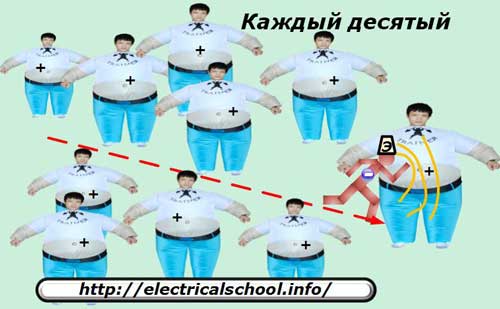
This phenomenon can be explained not only by the laws of fundamental classical physics, as commonly understood by most people, but also by the additional operating laws described by the theory of quantum mechanics.
If we briefly express their action, then we can imagine that the movement of electrons inside metals is hindered by heavy «swinging» large ions that provide additional resistance.
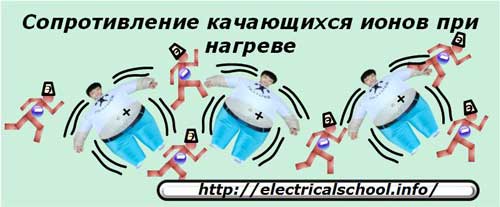
This effect is especially noticeable when heating metals, when the "swing" of heavy ions increases and reduces the electrical conductivity of the crystal lattices of the wires.
Therefore, when metals are heated, their electrical resistance always increases, and when cooled, their conductivity increases. When the temperature of the metal drops to critical values close to the value of absolute zero, the phenomenon of superconductivity occurs in many of them.
Electric current, depending on its value, is able to do different things. For a quantitative assessment of its capabilities, a value called amperage is taken. Its size in the international measurement system is 1 ampere. To indicate the current strength in the technical literature, the index «I» is adopted.
Voltage
This term is used as a characteristic of a physical quantity that expresses the work expended in transferring an electric charge of a test unit from one point to another without changing the nature of the placement of the remaining charges on the active field sources.
Since the starting and ending points have different energy potentials, the work done to move the charge, or voltage, is equal to the ratio of the difference between these potentials.
Different terms and methods are used to calculate the voltage depending on the currents flowing. Can not be:
1. constant — in electrostatic and constant current circuits;
2. alternating — in circuits with alternating and sinusoidal current.
For the second case, such additional characteristics and types of stress are used as:
-
amplitude — the largest deviation from the zero position of the abscissa axis;
-
instantaneous value, which is expressed at a certain point in time;
-
effective, effective or, otherwise called, root mean square value, determined by the active work performed for one half-period;
-
rectified average value calculated modulo the rectified value of one harmonic period.
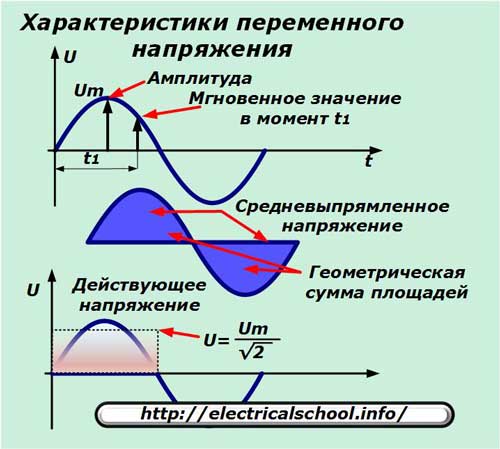
For the quantitative assessment of voltage, the international unit of 1 volt was introduced and the symbol «U» became its designation.
When transporting electrical energy through overhead lines, the design of the supports and their dimensions depend on the value of the voltage used. Its value between the conductors of the phases is called linear and relative to each conductor and earth phase.
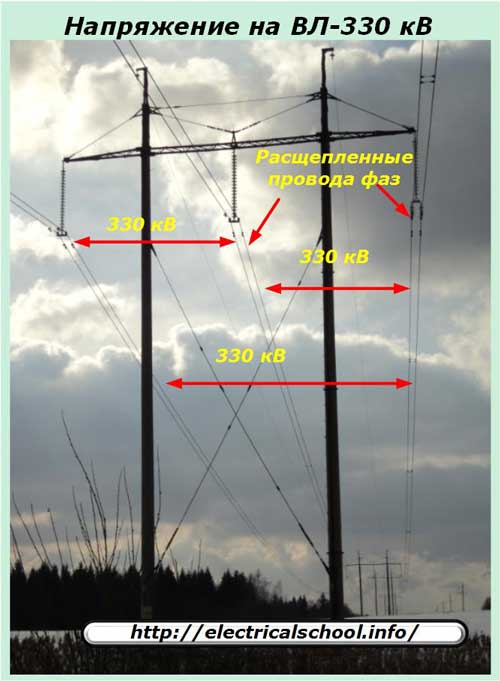
This rule applies to all types of airlines.
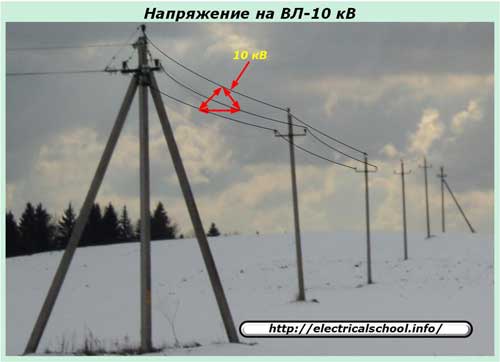
In domestic electrical networks of our country, the standard is a three-phase voltage of 380/220 volts.
Electrical resistance
The term is used to characterize the properties of a substance to weaken the passage of an electric current through it.In this case, different environments can be chosen, the temperature of the substance or its dimensions can be changed.
In DC circuits, the resistance does active work, which is why it is called active. For each section, it is directly proportional to the applied voltage and inversely proportional to the passing current.
The following concepts are introduced in alternating current schemes:
-
impedance;
-
wave resistance.
Electrical impedance is also called complex or component impedance:
-
active;
-
reactive.
Reactivity, in turn, can be:
-
capacitive;
-
inductive.
The connections between the impedance components of the resistance triangle are described.
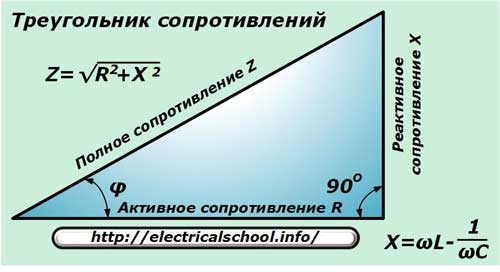
In an electrodynamics calculation, the wave impedance of a power line is determined by the ratio of the voltage from the incident wave to the value of the current passing along the wave line.
The resistance value is taken as an international unit of measurement of 1 Ohm.
The relationship of current, voltage, resistance
A classic example of expressing the relationship between these characteristics is a comparison with a hydraulic circuit, where the force of movement of the flow of life (analogue - the magnitude of the current) depends on the value of the force applied to the piston (created tension) and the nature of the flow lines, made of constrictions (resistance).
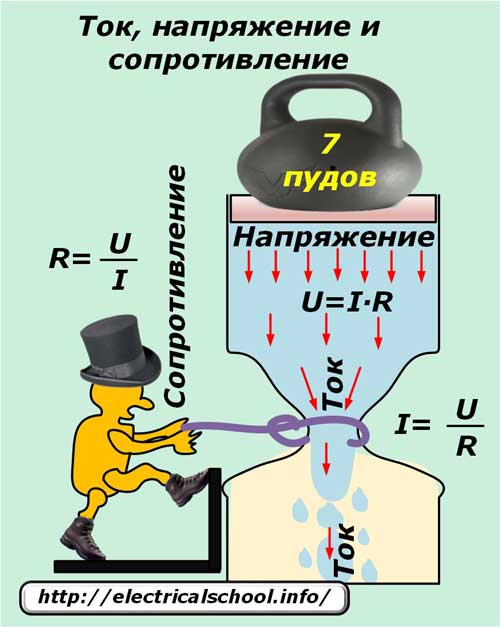
The mathematical laws describing the relationship of electrical resistance, current and voltage were first published and patented by Georg Ohm. He derived the laws for the entire circuit of the electric circuit and its section. See here for more details: Application of Ohm's law in practice
Ammeters, voltmeters and ohmmeters are used to measure the basic electrical quantities of electricity.
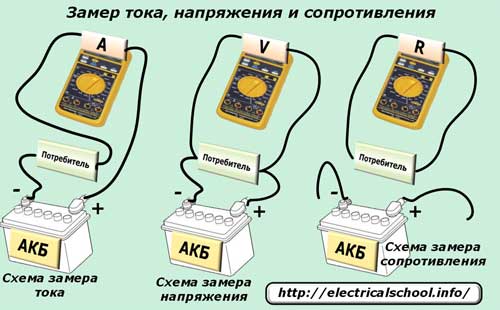
An ammeter measures the current flowing through the circuit. Since it does not change throughout the enclosed area, the ammeter is placed anywhere between the voltage source and the user, creating a passage of charges through the measuring head of the device.
A voltmeter is used to measure the voltage at the user's terminals connected to the current source.
Resistance measurements with an ohmmeter can only be made with the user switched off. This is because the ohmmeter outputs a calibrated voltage and measures the current flowing through the test head, which is converted to ohms by dividing the voltage by the current value.
Any connection of an external low-power voltage during the measurement will create additional currents and distort the result. Considering that the internal circuits of the ohmmeter are of low power, then in the case of erroneous resistance measurements when applying an external voltage, the device quite often fails due to the fact that its internal circuit burns out.
Knowing the basic characteristics of current, voltage, resistance and the relationships between them allows electricians to successfully perform their work and reliably operate electrical systems, and mistakes made very often end in accidents and injuries.
